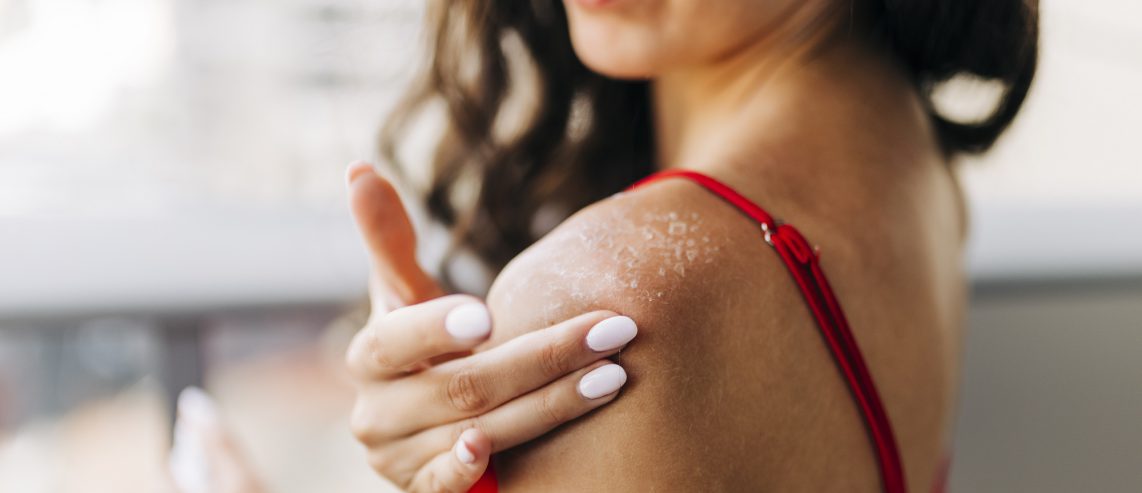You stayed out too long at the beach or pool, and now it looks like a painful sunburn is developing. Even worse, you notice some blisters forming on the worst parts of the burn. You’re not sure what to do — is it better to pop the blisters or let them heal on their own?
Here’s what you need to know about how to treat sun blisters.
What Is a Sun Blister?
A sun blister — a fluid-filled sac on the skin — happens as the result of a serious sunburn or sun poisoning. You get a sunburn when your skin gets overexposed to ultraviolet (UV) radiation from the sun.
Blisters usually appear several hours to a day after too much sun exposure. The blister forms to protect the skin underneath it.
Blistering skin indicates a second-degree burn. That means both the top (epidermis) and middle (dermis) layers of skin have sustained damage. “Sun blisters are preventable. By preventing blisters, we are protecting the skin from getting damaged”, says Sai Swapnika Guttikonda, MD; Franklin Community Medicine-UPMC. “If blisters occur, it is important to know how to manage with some simple home remedies. This can prevent skin infection and further skin damage. The knowledge on blisters would be helpful to prevent any risk of getting skin cancer in the long run,” adds Dr. Guttikonda.
Never Miss a Beat!
Subscribe to Our HealthBeat Newsletter!
Thank you for subscribing!
You can now select the specific newsletters you'd like to receive.
You are already subscribed.
Subscribe to more newsletters in our email preference center.
Sorry, an error occurred. Please try again later.
Get Healthy Tips Sent to Your Phone!
How To Treat Sun Blisters
It is often tempting to break a blister open, but you should fight the urge to do so. Leaving the blister alone will help it heal faster. A broken blister increases the chance of infection by letting bacteria into the skin.
A broken blister can also lead to scarring.
Here are some ways to treat sun blisters at home.
- If the blister breaks on its own, clean the area with mild soap and water. Apply an antibiotic ointment and cover the wound with a nonstick bandage.
- Bathe or shower with cool water to cool the blisters and relieve pain. You can also use cold compresses on the blisters for a similar effect.
- Take ibuprofen, which will relieve pain and reduce inflammation.
- Put a little aloe gel on the blisters to relieve pain and promote healing.
- Drink extra water to help prevent dehydration and promote healing. Blistering skin causes water loss.
- Protect your skin from the sun while blisters are healing. More sun will aggravate the painful burn. Wear loose clothing to cover the blisters if you need to go out.
How Long Do Sun Blisters Last?
A sun blister should start to feel better in about two days. It usually takes about a week for sunburn and sun blisters to fade. You may notice darker or lighter spots on the skin after the blister is gone.
Even though the blister will heal, skin damage from sunburn is long-lasting. Multiple sunburns increase your chance of getting skin cancer.
How To Protect Your Skin From Sun Blisters
The best way to deal with sunburn and sun blisters is to avoid them altogether. The good news is that both are entirely preventable, as long as you take precautions in the sun. Here are some sun safety tips that will help you avoid getting sun blisters.
- Always use a broad-spectrum, water-resistant sunscreen with at least SPF 30 when you go outdoors.
- Wear protective clothing (hat and sunglasses) outdoors.
- Reapply sunscreen every few hours and after swimming.
- Avoid going out in the sun between 11 a.m. and 4 p.m., when the UV index is at its highest.
When You Should Call a Doctor
You can treat most sunburns and sun blisters at home. But if you have any of the following symptoms following a bad sunburn, go to your doctor or urgent care facility.
- Fever.
- Chills.
- Nausea.
- Vomiting.
- Confusion.
- Severe blistering that covers more than 20% of your body.
- Extreme pain.
- Headaches.
- Blisters that turn yellow or red (which could indicate infection).
Remember that a bad sunburn is no joke. Taking care of your skin now can help prevent premature aging of the skin and getting skin cancer in the future.
Sources
About Dermatology
The UPMC Department of Dermatology diagnoses, treats, and manages numerous hair, skin, and nail conditions and diseases. We care for common and uncommon conditions, and our treatments include both surgical and nonsurgical options. We operate several specialty centers for various conditions. The UPMC Cosmetic Surgery and Skin Health Center is a comprehensive dermatologic laser facility, offering a full range of cosmetic services and procedures. With UPMC Hillman Cancer Center, we offer a Skin Cancer Program that provides complete care from screenings, diagnosis, treatment, and beyond. Find a dermatology provider near you.
